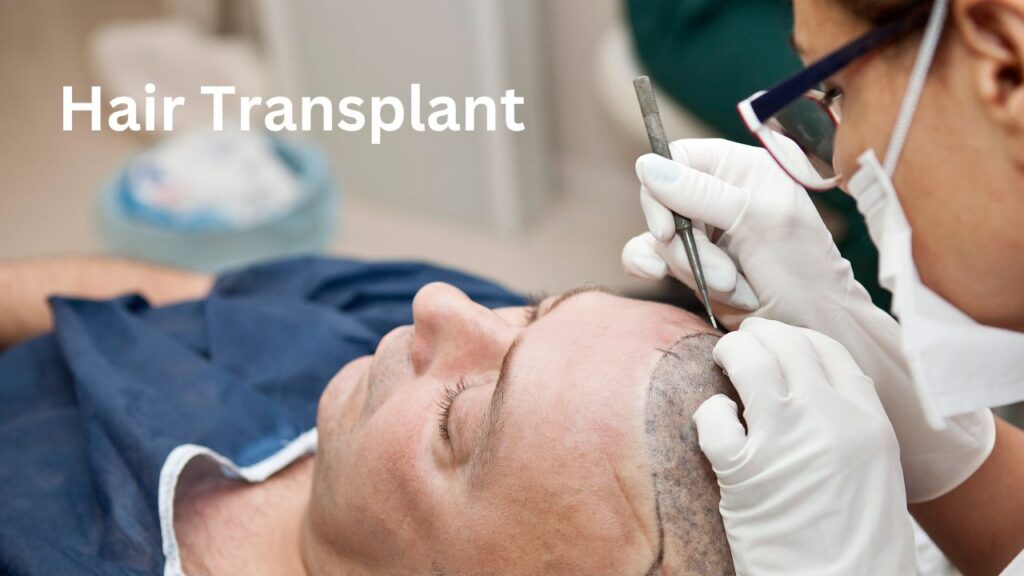
Hair transplantation is a cutting-edge surgical technique designed to restore hair growth in individuals experiencing baldness or thinning hair.
This procedure involves removing hair follicles from one part of the body, known as the “donor site,” and transplanting them to a bald or thinning area, referred to as the “recipient site.”
Hair transplants are primarily used to treat male pattern baldness, but they can also help individuals with hair loss due to injury or medical conditions.
How Does Hair Transplantation Work?
Hair transplantation is performed under local anesthesia in a hospital or a specialized clinic for Hair Transplant. The procedure begins with cleaning the scalp and injecting a numbing agent to minimize discomfort. There are two primary methods used for hair transplantation:
- Follicular Unit Strip Surgery (FUSS)
This method involves the following steps:
The surgeon removes a strip of skin from the back of the scalp, where hair is denser.
The removed strip is then divided into smaller follicular units containing individual hair follicles.
The surgeon carefully implants these follicular units into the recipient area to ensure a natural appearance.
- Follicular Unit Extraction (FUE)
The FUE technique is a more modern and minimally invasive approach:
Individual hair follicles are extracted directly from the donor site using a specialized tool.
These follicles are then implanted into the recipient area, mimicking the natural growth pattern.
FUE typically results in less scarring and a quicker recovery compared to FUSS.
Expectations and Recovery After a Hair Transplant
Post-surgery, patients may experience tenderness and mild discomfort in the scalp. Here’s what to expect during the recovery phase:
Bandages are usually required for 1-2 days post-surgery.
Pain medications, antibiotics, or anti-inflammatory drugs may be prescribed to manage discomfort and prevent infections.
Most individuals can resume work within 2 to 5 days following the procedure.
Hair shedding occurs within 2 to 3 weeks after surgery, a normal part of the hair restoration process.
New hair growth is typically noticeable within a few months, with around 60% of hair regrowth occurring within 6 to 9 months.
Some doctors may recommend minoxidil or other hair growth stimulants to enhance results, though their effectiveness varies from person to person.
Types of Hair Transplants
Hair transplantation techniques are categorized based on the type of grafts used:
- Slit Grafts
Ideal for achieving fuller, denser hair coverage.
- Micrografts
Contain 1 to 2 hair follicles per graft.
Best for natural-looking results and precise hairline restoration.
Who Can Benefit from a Hair Transplant?
A hair transplant can significantly improve one’s appearance and boost self-confidence. Ideal candidates include:
Men with male pattern baldness – The most common candidates.
Women with thinning hair – Especially those experiencing hair loss due to genetics or hormonal changes.
Individuals with hair loss from burns or scalp injuries – Hair transplants can restore lost hair caused by trauma.
Who is Not a Good Candidate for Hair Transplantation?
While hair transplantation offers promising results, it may not be suitable for everyone. Those who may not be ideal candidates include:
Women with widespread hair loss – If thinning occurs throughout the scalp, there may not be enough donor hair for a successful transplant.
Individuals with insufficient donor hair – A successful transplant requires healthy hair follicles from the donor area.
People prone to keloid scarring – Thick, fibrous scars may form after surgery, affecting the outcome.
Patients experiencing hair loss due to medications (e.g., chemotherapy) – In such cases, hair loss is often temporary and may not require a transplant.
Advantages of Hair Transplantation:
Permanent Solution: Unlike topical treatments and medications, hair transplants offer a long-lasting solution.
Natural Appearance: Modern techniques ensure that transplanted hair blends seamlessly with natural hair.
Minimal Maintenance: Once transplanted hair grows, it requires no special care beyond regular grooming.
Boost in Confidence: A fuller head of hair can significantly improve self-esteem and overall appearance.
Risks and Considerations:
Like any surgical procedure, hair transplantation comes with potential risks:
Infection or bleeding: Though rare, proper aftercare minimizes these risks.
Scarring: FUSS may leave a linear scar, whereas FUE results in minimal scarring.
Shock Loss: Some existing hair may temporarily fall out, but it usually regrows.
Uneven Growth: Some transplanted hair may grow at different rates, requiring touch-ups.
Cost of Hair Transplantation:
Hair transplant costs vary based on several factors:
The extent of hair loss and number of grafts needed.
The chosen transplant method (FUE is generally more expensive than FUSS).
The surgeon’s experience and clinic location.
Additional treatments like PRP therapy or medication.
Alternative Treatments for Hair Loss
If a hair transplant isn’t suitable, alternative treatments include:
Medications: Minoxidil and Finasteride can slow hair loss.
Platelet-Rich Plasma (PRP) Therapy: Involves injecting growth factors into the scalp to stimulate hair growth.
Low-Level Laser Therapy (LLLT): A non-invasive treatment that may promote hair regrowth.
Scalp Micropigmentation (SMP): A cosmetic procedure that creates the illusion of a fuller scalp.
Final Thoughts
Hair transplantation is an advanced, effective solution for hair loss, particularly for individuals with male pattern baldness, thinning hair, or hair loss due to injury. While the procedure offers long-term benefits, it’s essential to have realistic expectations and consult a qualified surgeon to determine the best approach.
If you’re considering a hair transplant, thorough research and consultation with an expert can help you make an informed decision. Whether through surgical intervention or alternative treatments, various solutions are available to restore hair and confidence.
